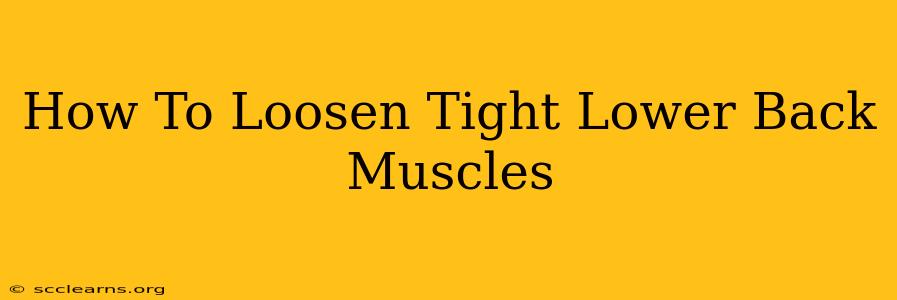Experiencing persistent lower back tightness? You're not alone. Many people suffer from this common ailment, often stemming from prolonged sitting, poor posture, stress, or strenuous activity. Fortunately, there are several effective ways to loosen those tight lower back muscles and alleviate the discomfort. This guide provides practical strategies to help you regain flexibility and ease your lower back pain.
Understanding Lower Back Tightness
Before diving into solutions, let's understand the root cause. Tight lower back muscles are frequently caused by:
- Prolonged Sitting: Spending hours seated, whether at a desk or in a car, can compress the spine and shorten the muscles.
- Poor Posture: Slouching or hunching puts extra strain on your lower back muscles, leading to tightness and pain.
- Lack of Exercise: Insufficient physical activity weakens the core muscles, which are crucial for supporting the lower back.
- Stress: Stress can cause muscle tension throughout the body, including the lower back.
- Injury: A previous injury, even a minor one, can lead to chronic muscle tightness in the area.
- Dehydration: Believe it or not, dehydration can affect muscle flexibility and contribute to tightness.
Effective Ways to Loosen Tight Lower Back Muscles
Now that we understand the potential culprits, let's explore effective methods to alleviate lower back tightness:
1. Gentle Stretching
Stretching is crucial for improving flexibility and relieving muscle tension. Here are some beneficial stretches:
- Knee-to-Chest Stretch: Lie on your back with knees bent. Gently pull one knee towards your chest, holding for 20-30 seconds. Repeat on the other side.
- Spinal Twist: Lie on your back with knees bent. Extend your arms out to the sides. Gently drop both knees to one side while keeping your shoulders flat on the floor. Hold for 20-30 seconds and repeat on the other side.
- Pigeon Pose (modified): Start on your hands and knees. Bring one knee forward behind your wrist, and extend the other leg back. Gently lower your hips towards the floor, holding for 20-30 seconds. Modify this by placing a pillow or blanket under your hips if needed.
- Child's Pose: Kneel on the floor with your big toes touching. Sit back on your heels (as best as you can) and fold forward, resting your forehead on the floor. Extend your arms out in front of you. Hold for 30 seconds to 1 minute.
Important Note: Always listen to your body and avoid pushing yourself too hard. Gentle stretches are more effective than forceful ones.
2. Low-Impact Exercise
Regular low-impact exercise strengthens core muscles and improves flexibility. Consider incorporating:
- Walking: A simple yet effective way to improve circulation and gently stretch the lower back.
- Swimming: The buoyancy of water supports your body while providing a full-body workout.
- Yoga: Specific yoga poses can target lower back muscles and improve flexibility.
- Pilates: This method focuses on core strengthening and improving posture, crucial for lower back health.
3. Heat and Ice Therapy
Both heat and ice can provide relief, depending on the type of pain and your preference:
- Heat: Apply a warm compress or take a warm bath to relax tight muscles.
- Ice: Use an ice pack wrapped in a towel to reduce inflammation and numb pain, particularly if you have acute pain or inflammation.
4. Massage Therapy
Massage can effectively relieve muscle tension and improve circulation in the lower back. A professional massage therapist can target specific areas of tightness and help restore flexibility. Self-massage using a foam roller or massage ball can also provide some relief.
5. Proper Posture
Maintaining good posture is essential for preventing and relieving lower back tightness. Be mindful of your posture while sitting, standing, and sleeping. Consider using ergonomic furniture and support devices, if necessary.
6. Hydration
Staying well-hydrated is crucial for overall health, including muscle function. Dehydration can contribute to muscle stiffness and tightness.
When to Seek Professional Help
While these methods can help alleviate lower back tightness, it's essential to seek professional medical help if:
- Your pain is severe or doesn't improve with home treatments.
- You experience numbness or tingling in your legs or feet.
- You have difficulty controlling your bowel or bladder.
- You've experienced a recent injury.
Your doctor or a physical therapist can properly diagnose the cause of your lower back pain and recommend the best course of action.
By incorporating these strategies into your daily routine, you can effectively loosen tight lower back muscles, improve flexibility, and alleviate discomfort. Remember consistency is key, and always listen to your body.

